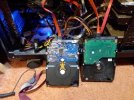Oh Dear... I've recently noticed our Fox T2 has been exhibiting "dropouts" in some recent recordings. It's vaguely reminiscent enough of the problems back in
https://hummy.tv/forum/threads/humax-faults-v-serial-number.688/#post-13779 (good grief almost a decade ago... no wonder the system might be getting flaky) to make me think it may be the disk starting to go bad.... although so far as I can tell the box doesn't crash and reboot (like it used to in those days), playback of recordings older than a few weeks ago is still completely fine and watching live content slightly behind (which is presumably buffered by the disk) has yet to exhibit any issues. And in those days the crashed recordings would just have a missing 3 minutes skip; these days the dropouts are preceded by a burst of multicoloured macroblock mess.
The disk test thing in the settings menu says no problems (but I'm not sure it ever did, even when there clearly were disk issues like with the boxes we had to get replaced originally). I'm still not using the custom firmware so don't have "fixdisk" option mentioned earlier in the thread (not yet anyway... maybe this'll finally get me to take the plunge).
Before embarking on a full HDD replacement project (this thread is a
fantastic resource)... I'm curious if anyone has any thoughts on how best to backup content over the ethernet interface? (Ours is still networked, from using iPlayer on it when that worked). Maybe not the full 2TB (yes, it's full of unwatched crud) but just of the subset of the backlog of stuff I'd be annoyed if it disappeared before I'd had a chance to watch it.
Enabling the FTP and MediaServer options and I can indeed obtain .ts files off the box via FTP from a desktop PC. However the files appear to be scrambled; I can't play them in Totem (Gnome Videos) or VLC (this is a Linux household). However .ts files obtained from the box's attached USB drive do not appear to be scrambled (this vaguely rings bells; something about the box scrambling content on it's HDD but unscrambling it when it copies it to an external USB drive... which is partly why such copying is so slow).
I can also browse the Hummy box's main drive (not the attached USB drive) from the desktop as a UPnP service using VLC or Totem. VLC can play content fine (but Totem not; not sure why).
I'm not really familiar with UPnP and media servers though. I could imagine scripting some FTP commands to pull lots of files off the box as a batch job via that route... but if they're scrambled they seem not much use (unless there's an easy way to unscramble?). Access via UPnP seems more promising - in that the content seems to be served up de-scrambled - but it's not obvious how to save the files or if it can be done faster than real-time (FTP is slow, but still an order of magnitude faster than real-time). Ideally I'd be looking for something to batch-copy from UPnP like it was a filesystem, or for something like curl or wget giving command line access to UPnP... any ideas?
Alternatively it might be easier to just obtain another external USB HDD and back-up onto that. But given that I currently have plenty of free disk space on my desktop machine but no spare external USB drives other than a few old ones with 10s of GBs only, the networked approach is more immediately attractive. Or is it basically a dumb idea?




